When you’re looking to maximize safety while driving, there are few things as crucial as the quality of your tires. Obviously, they’re responsible for getting your vehicle from point A to point B, but there’s more to your tires than just that. A well-maintained set of tires can save your life in heavy rain or other hazardous driving conditions. They also play a significant role in your fuel efficiency, if they’re properly inflated.
So, if tires are so important, then why is it such a headache to navigate the tire replacement process? With many different brands and types of tires to consider, it’s easy to get overwhelmed by the options and settle on the cheapest set available.
However, it’s vital to understand the ins and outs of replacement tires before you need them. That way, you can be properly informed about what’s best for your needs as a driver.
If you’re looking for more information before going to replace your tires, you’ve come to the right place for all the things to know before buying tires!
What to know before buying new tires?
There are many questions to consider when buying new tires, and it varies for every car owner. Some depend on where you live, or the time of year you’re looking to buy new tires. Others hinge on your specific driving style, or just how often you use your vehicle.
Here are several examples of questions you should know the answer to before buying a new set of tires:
- When was the last time I had my tires replaced?
- What are the recommended tires for my vehicle?
- How many miles do I drive each month?
- Should I replace some or all of my tires?
- What is my budget for new tires?
- Can I afford to buy new tires, or should I consider used ones?
As you can see, there are many different areas to hone in on whenever you're buying tires.
Generally, if you’ve had the same set of tires for 5 years or more, you should consider replacing them to avoid losing traction when braking. The others vary from person to person and require knowledge of the different types of tires, plus their benefits, costs, and availability.
Let’s break those areas down and explore what you should know before you buy.
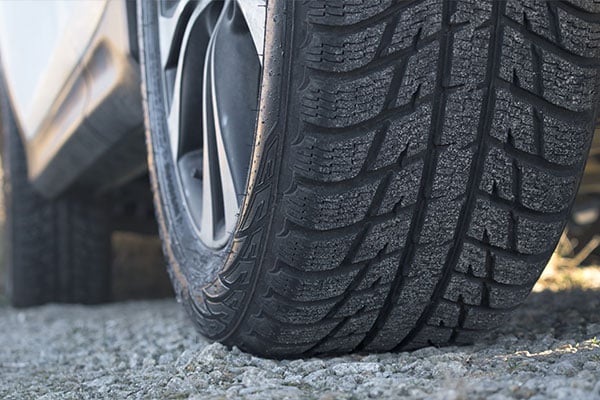
What are the different types of tires?
Using the proper tires is crucial for your automobile because, in some cases, they can be the difference between life and death. Therefore, knowing even a little bit about the different types of tires can simplify the task of equipping your car with the right tires for the job.
There are four different types of tires that are commonly available for car owners:
- Summer
- Winter
- All-Season
- All-Terrain
Summer
Summer tires are generally used for sports cars or other models focused on high performance. Despite their name, they can be used in spring, summer, and autumn months. They provide increased traction in moderate to warm temperatures, rain or shine.
But once temperatures begin to fall, their performance similarly plummets. Below 46 degrees Fahrenheit, the tire compounds begin to harden, resulting in inconsistent performance and decreased traction.
If you drive a higher-end vehicle and live in a warmer climate, summer tires are a top choice for improved performance. Otherwise, these tires may not be the best choice for you.
Winter
Winter tires are the best choice for anyone living in a colder climate where temperatures stay below 40 degrees for at least three months each year. While they’re also known as “snow tires,” they are not purely for driving in the snow. In fact, they perform exceptionally well in all cold weather conditions, in addition to increased traction when driving on snow or ice, thanks to their deeper tire treads.
The compounds in winter tires are designed to be flexible in cold weather, which means they won’t handle as well once the seasons change. Winter tires can also come studded for drivers in tundra climates but are commonly unstudded for anyone living in the Northern US.
All-Season
If you own a standard sedan, hatchback, or SUV, then all-season tires are the most commonly available type of tire for your vehicle. As you can guess by their name, they fall in between the dedicated focuses of summer and winter tires. They provide consistent performance throughout the year, regardless of weather conditions.
That said, all-season tires do not match the traction of winter tires or the sharp steering and handling of summer tires. They are a jack of all trades, perfect for car owners in mild climates where snow is infrequent but not impossible. What drivers often like most about all-season tires is the length of their tire tread, which offers significant lifetime value with routine tire rotations.
All-Terrain
Finally, there are all-terrain tires. Similar to all-season tires, they offer consistency throughout an entire year but are beaten out by winter tires when the snow starts piling high. These are often used by SUVs or truck drivers looking to go have fun off-roading. Whether you’re taking dirt or gravel roads, or climbing up steep rocky trails, all-terrain tires are the best choice for you.
On the flip side, all-terrain tires can be much noisier, due to their deeper tread design. They also are middling in terms of fuel efficiency, and have a shorter tread life than any other tire, due to their more intense use cases.
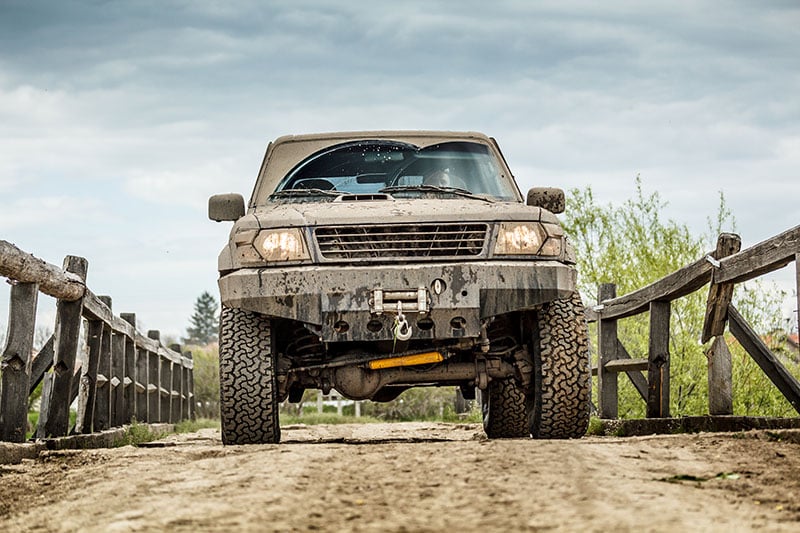
What tire size do I need?
When you’re looking for replacement tires, you want to make sure that you’re purchasing the appropriate size for your vehicle. This information should be located in your owner’s manual, but you can also search online with your vehicle make, model, and year to double-check.
Here’s a handy table to break down the three standard tire sizes:
|
Wheel diameter |
Vehicle type |
|
Small -- 12” - 15” |
Compact cars, high-performance sports cars |
|
Medium -- 16” - 20” |
Crossovers, SUVs, small trucks, vans |
|
Large -- 18” - 28” |
Large trucks, all-terrain SUVs |
Since a vast majority of car owners drive crossovers, SUVs, and smaller trucks, medium-sized tires (16 to 20 inches) are the most common.
Of course, there’s more to tire size than their diameter. You also have to take tire width, aspect ratio, radial-tire designation, load and speed ratings, tread-wear ratings, traction and temperature ratings, and any vehicle-specific markings. All of that can be found on a tire’s sidewall.
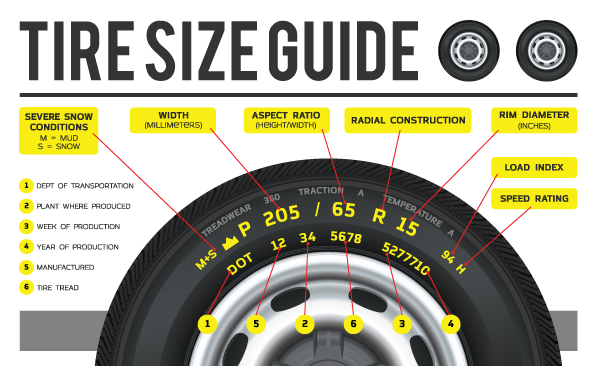
If you’ve ever wondered what all the numbers and letters on a tire mean, it’s all specifications for that unique tire. (Car and Driver has an excellent, more detailed breakdown for those interested.)
How much do new tires cost?
So, now you’re a bit more informed about buying tires than you were a few minutes ago. How do you start the process of actually buying new tires? For starters, you’ll need to have an idea of your budget when you go to replace your tires. While some people may swear by replacing tires individually, this is generally discouraged for those with worn tires. You can get away with it if you are replacing a popped tire, but you’ll want a completely new set whenever you’re replacing visibly old tires.
Generally, tire pricing varies depending on a combination of factors: quality, size, and type. We’ve spoken about the latter two, but quality breaks the cost down into additional tiers - each with their own price range:
- Budget tires: typically $50 to $150 each.
- Mid-range tires: typically $100 to $300 each.
- High-end/specialty tires: anywhere from $300 to $1000 each
With all this information in mind, let’s do the math for a new set of tires, based on some of the best-selling models available:
|
Make & model |
Tire size |
Price estimate |
|
2021 Ford F-150 |
All-season, 17” 245/75 |
$198 each, $792 total |
|
2021 Toyota RAV4 |
All-season, 17” 225/65 |
$120 each, $480 total |
|
2021 Honda Civic |
All-season, 17” 215/50 |
$98 each, $392 total |
No matter which make and model you own, the cost of tires will likely vary compared to friends, family, or neighbors - unless you happen to own the exact same year, model, and trim level. The chart above doesn’t take into account the most expensive options either, but rather the standard mainstream options based on size and type.
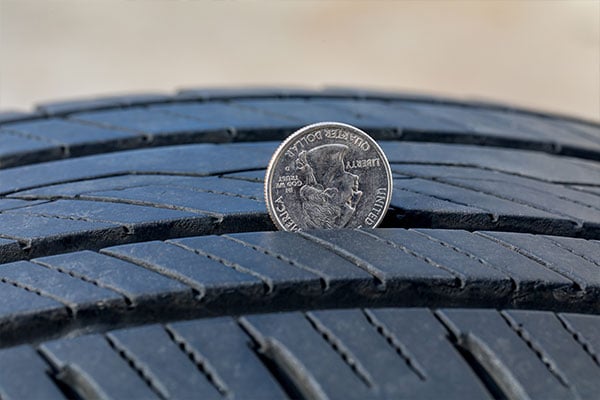
What to expect with cheap tires
When you’re looking at spending $400 or more on anything, it’s easy to find cheaper alternatives to minimize that total cost. There’s nothing wrong with trying to limit the weight of a sizable, long-term investment on your short-term budget.
However, shopping with tires is a different experience than trying to find a new TV or couch. As we mentioned before, every tire is specifically crafted with over a dozen different properties to consider. While cheaper tires have a lower barrier to purchase, they often have worse traction, handling, and braking performance, due to lower quality rubber.
The most important thing to remember when buying new tires is that you’re purchasing something that should last five to six years. Quality should always come first, especially when it impacts the safety of you and your passengers. While a cheaper set of tires may save a couple hundred dollars now, they also may get you into an accident because you couldn’t completely brake fast enough.
Of course, it’s best to make whichever decision works for you. Just be sure to weigh every option and scenario before settling on a cheaper set of tires.
What should I know about used tires?
It should go without saying that buying tires older than six years is a dangerous decision, especially if you’re already looking to replace your old tires. But what about tires that are only a few years old? Maybe you know someone selling a set, or there’s a great deal at a local tire shop you want to jump on. What then?
Unless you know exactly how many miles a set of used tires has been driven, it’s not worth the cost to purchase. The seller may say they’ve used them for a year, but fail to mention the fact they drove 30,000 miles in that period of time. Tires also have a limited lifespan of five to six years, regardless of use. That’s because the older your tires are, the more likely they are to rubber fatigue - like tread separation or sidewall ruptures.
In the end, buying used tires means purchasing a vital component of your vehicle with a decreased lifespan. It makes sense if you’re struggling to get by, but even then it can be a recipe for greater financial burden down the line. While the savings from a set of used tires might be tempting, the long-term value is not worth the short period of effectiveness.
What to prioritize when choosing new tires
Before you head out to replace your tires, let’s take a final moment to recap the top priorities you should consider when making the purchase:
Safety comes first.
When you’re making any decision about buying tires, remember the role they play in keeping you safe. While used or cheaper new tires may be enticing in terms of savings, they can also come back to haunt you down the road if you’re not careful.
Know your tires.
If you’re a new driver or just moved to a different climate, it’s important to be informed about the different types of tires available. Don’t underestimate the impact of a good set of winter tires if you live somewhere that gets snow. The same goes for summer tires if you live somewhere like Florida.
Keep your tires lasting long.
Tires typically last six years, but only if you practice routine maintenance. Without it, you can expect uneven tread wear that will lower the lifespan of your tires. In case you didn’t know, it’s recommended that you have your tires rotated every 6 months or 6,000 to 8,000 miles - whichever comes first.
When in doubt, consult the experts.
If you are confused about which tires to get for your car, don’t be afraid to lean on your manufacturer. The owner’s manual is a wonderful resource, but your local dealership mechanics can help explain anything that is challenging to wrap your head around.
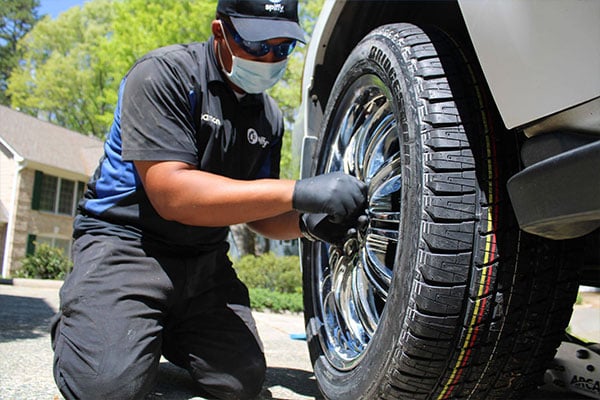
What’s better: a traditional or mobile tire change service?
One thing that most drivers can agree on is that actually getting your tires replaced can be a headache to deal with. It takes time out of your day to drive to your dealership or a mechanic and wait, or having to drop your car off and pick it up later.
For those seeking a more convenient tire service option, mobile tire change has continued to grow into a mainstream choice for getting your tires replaced with ease. Rather than taking time out of your day to have a mechanic swap your old tires for new ones, you can enjoy the satisfaction of a certified technician coming directly to you.
Finally, one of the more tedious parts of vehicle maintenance can be simplified without having to schedule your whole day around it!
Enjoy mobile tire installation at home
Looking for mobile tire change services near you? That’s where Spiffy comes in. We find the exact tires for your vehicle, then our expertly trained technicians come ready to replace your old set with ease.
Check out our services page to see if our tire services are available in your area!
Posted in Car Care





